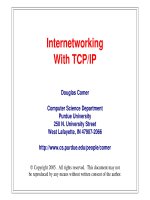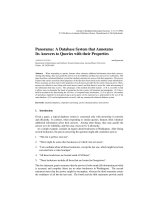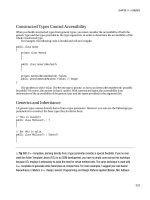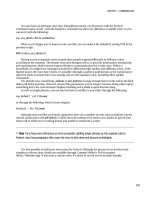Internetworking with TCP/IP- P16 potx
Bạn đang xem bản rút gọn của tài liệu. Xem và tải ngay bản đầy đủ của tài liệu tại đây (508.36 KB, 10 trang )
Internet
Protocol:
Routing
IP
Datagrams Chap.
8
Because the internet addresses of all machines on a single network in-
clude a common network pre& and extracting that pre& requires
only a few machine instructions, testing whether a machine can be
reached directly is extremely eficient.
From an internet perspective, it is easiest to think of direct delivery as the final
step in any datagram transmission, even
if
the datagram traverses many networks and
intermediate routers. The final router along the path between the datagram source and
its destination will connect directly to the same physical network as the destination.
Thus, the final router will deliver the datagram using direct delivery. We can think of
direct delivery between the source and destination as a special case of general purpose
routing
-
in a direct route the datagram does not happen to pass through any intervening
routers.
8.3.2
Indirect
Delivery
Indirect delivery is more difficult than direct delivery because the sender must
identify a router to which the datagram can be sent. The router must then forward the
datagram on toward its destination network.
To visualize how indirect routing works, imagine a large internet with many net-
works interconnected by routers but with only two hosts at the far ends. When one host
wants to send to the other, it encapsulates the datagram and sends it to the nearest
router.
We know that the host can reach a router because all physical networks are in-
terconnected, so there must
be
a router attached to each network. Thus, the originating
host can reach a router using a single physical network. Once the frame reaches the
router, software extracts the encapsulated datagram, and the
IP
software selects the next
router along the path towards the destination. The datagram is again placed in a frame
and sent over the next physical network to a second router, and so on, until it can be
delivered directly. These ideas can be summarized:
Routers in a
TCPAP
internet form a cooperative, interconnected
structure. Datagrams pass from router to router until they reach a
router that can deliver the datagram directly.
How can a router know where to send each datagram? How can a host know
which router to use for a given destination? The two questions are related because they
both involve
IP
routing. We will answer them in two stages, considering the basic
table-driven routing algorithm in this chapter and postponing a discussion of how
routers learn new routes until later.
Sec.
8.4
Table-Driven
IP
Routing
8.4
Table-Driven IP Routing
The usual
IP
routing algorithm employs an
Internet routing table
(sometimes
called an
IP routing table)
on each machine that stores information about possible desti-
nations and how to reach them. Because both hosts and routers route datagrams, both
have
IP routing tables. Whenever the
IP
routing software in a host or router needs to
transmit a datagram, it consults the routing table to decide where to send the datagram.
What information should be kept in routing tables?
If
every routing table con-
tained information about every possible destination address, it would be impossible to
keep the tables current. Furthermore, because the number of possible destinations is
large, machines would have insufficient space to store the information.
Conceptually, we would like to use the principle of information hiding and allow
machines to make routing decisions with minimal information. For example, we would
like to isolate information about specific hosts to the local environment in which they
exist and arrange for machines that are far away to route packets to them without know-
ing such details. Fortunately, the IP address scheme helps achieve this goal.
Recall
that IP addresses are assigned to make all machines connected to a given physical net-
work share a common prefix (the network portion of the address). We have already
seen that such an assignment makes the test for direct delivery efficient. It also means
that routing tables only need to contain network prefixes and not full
IP
addresses.
8.5
Next-Hop Routing
Using the network portion of a destination address instead of the complete host ad-
dress makes routing efficient and keeps routing tables small. More important, it helps
hide information, keeping the details of specific hosts confined to the local environment
in which those hosts operate. Typically, a routing table contains pairs (N,
R),
where N
is the
IP
address of a destination
network,
and
R
is the IP address of the "next" router
along the path to network N. Router
R
is called the
next hop,
and the idea of using a
routing table to store a next hop for each destination is called
next-hop routing.
Thus,
the routing table in a router
R
only specifies one step along the path from
R
to a desti-
nation network
-
the router does not know the complete path to a destination.
It is important to understand that each entry in a routing table points to a router
that can be reached across a single network. That is, all routers listed in machine M's
routing table must lie on networks to which
M
connects directly. When a datagram is
ready to leave
M,
IP software locates the destination
IP
address and extracts the network
portion.
M
then uses the network portion to make a routing decision, selecting a router
that can
be
reached directly.
In
practice, we apply the principle of infomlation hiding to hosts as well. We in-
sist that although hosts have
IP
routing tables, they must keep minimal information in
their tables. The idea is to force hosts to rely on routers for most routing.
Figure
8.2
shows
a
concrete example that helps explain routing tables. The exam-
ple internet consists of four networks connected by three routers. In the figure, the rout-
120
Internet Protocol: Routing
IP
Datagram
Chap.
8
ing table gives the routes that router
R
uses. Because
R
connects directly to networks
20.0.0.0 and 30.0.0.0, it can use direct delivery to send to a host on either of those net-
works (possibly using
ARP
to find physical addresses). Given
a
datagram destined for
a host on network 40.0.0.0,
R
routes it to the address of router
S,
30.0.0.7.
S
will then
deliver the datagram directly.
R
can reach address 30.0.0.7 because both
R
and
S
attach
directly to network 30.0.0.0.
TO REACH HOSTS ROUTE TO
ON NETWORK THIS ADDRESS
I
20.0.0.0
I
DELIVER DIRECTLY
I
30.0.0.0
I
DELIVER DIRECTLY
Figure
8.2
(a)
An example intemet with
4
networks and
3
routers, and
(b)
the
routing table in
R.
As Figure
8.2
demonstrates, the size of the routing table depends on the number of
networks in the intemet; it only grows when new networks are added. However, the
table size and contents are independent of the number of individual hosts connected to
the networks. We can summarize the underlying principle:
To hide information, keep routing tables small, and make routing de-
cisions efficient,
IP
routing software only keeps information about
destination network addresses, not about individual host addresses.
Sec.
8.5
Next-Hop Routing 121
Choosing routes based on the destination network ID alone has several conse-
quences. First, in most implementations, it means that all traffic destined for a given
network takes the same path. As a result, even when multiple paths exist, they may not
be used concurrently. Also, all types of traffic follow the same path without regard to
the delay or throughput of physical networks. Second, because only the final router
along the path attempts to communicate with the destination host, only it can
deternine
if the host exists or is operational. Thus, we need to arrange a way for that router to
send reports of delivery problems back to the original source. Third, because each
router forwards traffic independently, datagrams traveling from host
A
to host
B
may
follow an entirely different path than datagrams traveling from host
B
back to host
A.
We need to ensure that routers cooperate to guarantee that two-way communication is
always possible.
8.6
Default Routes
Another technique used to hide information and keep routing table sizes small con-
solidates multiple entries into a default case. The idea is to have the IP routing software
first look in the routing table for the destination network. If no route appears in the
table, the routing routines send the datagram to a
default router.
Default routing is especially useful when a site has a small set of local addresses
and only one connection to the rest of the internet. For example, default routes work
well in host computers that attach to a single physical network and reach only one
router leading to the remainder of the internet. The routing decision consists of two
tests: one for the local net and a default that points to the only router. Even if the site
contains a few local networks, the routing is simple because it consists of a few tests for
the local networks plus a default for all other destinations.
8.7
Host-Specific Routes
Although we said that all routing is based on networks and not on individual hosts,
most IP routing software allows per-host routes to be specified as a special case. Hav-
ing per-host routes gives the local network administrator more control over network use,
permits testing, and can also be used to control access for security purposes. When de-
bugging network connections or routing tables, the ability to specify a special route to
one individual machine turns out to
be
especially useful.
8.8
The
IP
Routing Algorithm
Taking into account everything we have said, the IP algorithm used to forward da-
tagrams becomes?:
tChapter
10
discusses
a
slightly modified algorithm used with classless
IP
addresses.
122
Internet
Protocol: Routing
IP
Datagrams Chap.
8
Algorithm:
RouteDatagram (Datagram, RoutingTable)
Extract destination IP address, D, from the datagram
and compute the network prefix,
N;
if
N
matches any directly connected network address
deliver datagram to destination D over that network
(This involves resolving D to a physical address,
encapsulating the datagram, and sending the frame.)
else if the table contains a host-specific route for D
send datagram to next-hop specified in table
else if the table contains a route for network
N
send datagram to next-hop specified in table
else if the table contains a default route
send datagram to the default router specified in table
else declare a routing error;
Figure
83
The algorithm
IP
uses to forward a datagram. Given
an
IF'
da-
tagram
and
a routing table, this algorithm selects
the
next hop to
which
the
datagram should
be
sent. All routes must specify a
next hop that lies on a directly
COM~C~~
network.
8.9
Routing With
IP
Addresses
It is important to understand that except for decrementing the time to live and
recomputing the checksum,
IP
routing does not alter the original datagram. In particu-
lar, the datagram source and destination addresses remain unaltered; they always specify
the
IP
address of the original source and the
IP
address of the ultimate destination?.
When
IP
executes the routing algorithm, it selects a new
IP
address, the
IP
address of
the machine to which the datagram should be sent next. The new address is most likely
the address of a router. However, if the datagram can be delivered directly, the new ad-
dress is the same as the address of the ultimate destination.
We said that the
IP
address selected by the
IP
routing algorithm is known as the
next
hop
address because it tells where the datagram must be sent next. Where does
IP
store the next hop address? Not in the datagram; no place is reserved for it. In fact,
IP
does not "store" the next hop address at all. After executing the routing algorithm,
IP
passes the datagram and the next hop address to the network interface software respon-
sible for the physical network over which the datagram must be sent. The network in-
tThe only exception occurs when the datagram contains a source route option.
Sec.
8.9
Routing With
IP
Addresses
123
terface software binds the next hop address to a physical address, forms a frame using
that physical address, places the datagram in the data portion of the frame, and sends
the result. After using the next hop address to find a physical address, the network in-
terface software discards the next hop address.
It may seem odd that routing tables store the
IP
address of a next hop for each des-
tination network when those addresses must be translated into corresponding physical
addresses before the datagram can
be
sent.
If
we imagine a host sending a sequence of
datagrams to the same destination address, the use of
IF'
addresses will appear incredi-
bly inefficient.
IP
dutifully extracts the destination address in each datagram and uses
the routing table to produce a next hop address. It then passes the datagram and next
hop address to the network interface, which recomputes the binding to a physical ad-
dress. If the routing table used physical addresses, the binding between the next hop's
IP
address and physical address could
be
performed once, saving unneeded computa-
tion.
Why does
IP
software avoid using physical addresses when storing and computing
routes? As Figure
8.4
illustrates, there are two important reasons.
EXAMINATION
OR
DATAGRAM
UPDATES
OF
ROUTES
TO
BE
ROUTED
u
ZP addresses used
Physical addresses used
-1
DATAGRAM
TO BE
SENT
PLUS
ADDRESS
OF
NEXT
HOP
Figure
8.4
IP
software and the routing table it uses reside above the address
boundary. Using only
IP
addresses makes routes easy
to
examine
or
change and hides
the
details
of
physical addresses.
First, the routing table provides an especially clean interface between
IP
software
that routes datagram and high-level software that manipulates routes. To debug rout-
ing problems, network managers often need to examine the routing tables. Using only
IF'
addresses in the routing table makes it easy for managers to understand and to deter-
mine whether software has updated the routes correctly. Second, the whole point of the
Internet Protocol is to build an abstraction that hides the details of underlying networks.
124
Internet Protocol: Routing
IP
Datagram Chap.
8
Figure
8.4
shows the
address
boundary,
the important conceptual division between
low-level software that understands physical addresses and internet software that only
uses high-level addresses. Above this boundary, all software can be written to com-
municate using internet addresses; knowledge of physical addresses is relegated to a few
small, low-level routines. We will see that observing the boundary also helps keep the
implementation of remaining TCPJIP protocols easy to understand, test, and modify.
8.1
0
Handling Incoming Datagrams
So far, we have discussed IP routing by describing how forwarding decisions are
made about outgoing packets. It should be clear, however, that
IP
software must pro-
cess incoming datagrams as well.
When an IP datagram arrives at a host, the network interface software delivers it to
the
IP
module for processing. If the datagram's destination address matches the host's
IP address,
IP
software on the host accepts the datagram and passes it to the appropriate
higher-level protocol software for further processing. If the destination
IP
address does
not match, a host is required to discard the datagram (i.e., hosts are forbidden from at-
tempting to forward datagrams that are accidentally routed to the wrong machine).
Unlike hosts, routers perform forwarding. When an
IP
datagram arrives at a
router, it is delivered to the
IP
software. Again, two cases arise: the datagram could
have reached its final destination, or it may need to travel further. As with hosts, if the
datagram destination IP address matches the router's own
IP
address, the
IP
software
passes the datagram to higher-level protocol software for processingt.
If
the datagram
has not reached its final destination,
IP
routes the datagram using the standard algorithm
and the information in the local routing table.
Determining whether an
IP
datagram has reached its final destination is not quite
as trivial as it seems. Remember that even a host may have multiple physical connec-
tions, each with its own
IP
address. When an IP datagram arrives, the machine must
compare the destination internet address to the
IP
address for each of its network con-
nections.
If
any match, it keeps the datagram and processes it.
A
machine must also
accept datagrams that were broadcast on the physical network if their destination IP ad-
dress is the limited IP broadcast address or the directed
IP
broadcast address for that
network. As we will see
in
Chapters
10
and
17,
classless, subnet, and multicast ad-
dresses make address recognition even more complex. In any case,
if
the address does
not match any of the local machine's addresses, IP decrements the time-to-live field in
the datagram header, discarding the datagram if the count reaches zero, or computing a
new checksum and routing the datagram if the count remains positive.
Should every machine forward the
IP
datagrams it receives? Obviously, a router
must forward incoming datagrams because that is its main function. We have also said
that some multi-homed hosts act as routers even though they are really general purpose
computing systems. While using a host as a router is not usually a good idea, if one
chooses to use that arrangement, the host must be configured to route datagrams just as
a router does. But what about other hosts, those that are not intended to be routers?
+Usually, the only datagrams destined for a router
are
those used to test connectivity or those that
carry
router management commands, but a router must also keep a copy of datagrams that are broadcast on the net-
work.
Sec.
8.10
Handling Incoming
Datagrams
125
The answer is that hosts not designated to
be
routers should
not
route datagrams that
they receive; they should discard them.
There are four reasons why a host not designated to serve as a router should refrain
from
perfom~ng any router functions. First, when such a host receives a datagram in-
tended for some other machine, something has gone wrong with internet addressing,
routing, or delivery. The problem may not
be
revealed if the host takes corrective ac-
tion by routing the datagram. Second, routing will cause unnecessary network traffic
(and may steal
CPU
time from legitimate uses of the host). Third, simple errors can
cause chaos. Suppose that every host routes traffic, and imagine what happens if one
machine accidentally broadcasts a datagram that is destined for some host,
H.
Because
it has been broadcast, every host on the network receives a copy of the datagram.
Every host forwards its copy to
H,
which will
be
bombarded with many copies. Fourth,
as
later chapters show, routers do more than merely route traffic. As the next chapter
explains, routers use a special protocol to report errors, while hosts do not (again, to
avoid having multiple error reports bombard a source). Routers also propagate routing
information to ensure that their routing tables are consistent. If hosts route datagrams
without participating fully in all router functions, unexpected anomalies can arise.
8.1 1 Establishing Routing Tables
We have discussed how
IP
routes datagram based on the contents of routing
tables, without saying how systems initialize their routing tables or update them
as
the
network changes. Later chapters deal with these questions and discuss protocols that al-
low routers to keep routes consistent. For now, it is only important to understand that
IP
software uses the routing table whenever it decides how to forward a datagram, so
changing routing tables will change the paths datagrams follow.
8.12 Summary
IP
uses routing information to forward datagrams; the computation consists of de-
ciding where to send a datagram based on its destination
IP
address. Direct delivery is
possible if the destination machine lies on a network to which the sending machine at-
taches; we think of this
as
the final step in datagram transmission.
If
the sender cannot
reach the destination directly, the sender must forward the datagram to a router. The
general paradigm is that hosts send indirectly routed datagrams to the nearest router; the
datagrams travel through the internet from router to router until they can
be
delivered
directly across one physical network.
When
IP
software looks up
a
route, the algorithm produces the
1P
address of the
next machine (i.e., the address of the next hop) to which the datagram should be sent;
IP
passes the datagram and next hop address to network interface software. Transrnis-
sion of a datagram from one machine to the next always involves encapsulating the da-
tagram
in
a physical frame, mapping the next hop internet address to a physical address,
and sending the frame using the underlying hardware.
126
Internet Protocol:
Routing
IF'
Datagrams Chap.
8
The internet routing algorithm is table driven and uses only
IP
addresses.
Although it is possible for a routing table to contain a host-specific destination address,
most routing tables contain only network addresses, keeping routing tables small. Us-
ing a default route can also help keep a routing table small, especially for hosts that can
access only one router.
FOR FURTHER STUDY
Routing is an important topic. Frank and Chou [1971] and Schwartz and Stem
[I9801 discuss routing in general; Postel [1980] discusses internet routing. Braden and
Postel [RFC 10091 provides a summary of how Internet routers handle IP datagram.
Narten [I9891 contains a survey of Intemet routing. Fultz and Kleinrock [I9711
analyzes adaptive routing schemes; and McQuillan, Richer, and Rosen [I9801 describes
the
ARPANET adaptive routing algorithm.
The idea of using policy statements to formulate rules about routing has been con-
sidered often. Leiner [RFC 11241 considers policies for interconnected networks.
Braun
[RFC
11041 discusses models of policy routing for internets, Rekhter [RFC 10921
relates policy routing to the second NSFNET backbone, and Clark
[RFC
11021
describes using policy routing with
IP.
EXERCISES
Complete routing tables for all routers in Figure
8.2.
Which routers will benefit most from
using a default route?
Examine the routing algorithm used on your local system.
Are
all
the cases mentioned in
the chapter covered? Does the algorithm allow anything not mentioned?
What does a router do with the
time to live
value in an
IF'
header?
Consider a machine with two physical network connections and two
IP
addresses
I,
and
I,.
Is it possible for that machine to receive a datagram destined for
I,
over the network with
address
I,?
Explain.
Consider two hosts,
A
and B, that both attach to a common physical network,
N.
Is it ever
possible, when using our routing algorithm, for
A
to receive a datagram destined for B?
Explain.
Modify
the routing algorithm to accommodate the
IF'
source route options discussed in
Chapter
7.
An
IP
router must perform a computation that takes time proportional to the length of the
datagram header each time it processes a datagram. Explain.
A
network administrator argues that to make monitoring and debugging his local network
easier, he wants to rewrite the routing algorithm so it tests host-specific routes
before
it
tests for direct delivery. How can he use the revised algorithm to build a network monitor?
Exercises
127
8.9
Is it possible to address a datagram to a router's
IP
address? Does it make sense to do so?
8.10
Consider a modified routing algorithm that examines host-specific routes before testing for
delivery on directly connected networks. Under what circumstances might such
an
algo-
rithm be desirable? undesirable?
8.11
Play detective: after monitoring
IP
traffic on a local area network for
10
minutes one even-
ing, someone notices that all frames destined for machine A carry
IP
datagrams that have
destination equal to A's
IP
address, while all frames destined for machine B carry
IP
da-
tagrams with destination
not
equal to B's
IP
address. Users report that both A and
B
can
communicate. Explain.
8.12
How could you change the
IP
datagram format to support high-speed packet switching at
routers? Hint: a router must recompute a header checksum after decrementing the time-to-
live field.
8.13
Compare
CLNP,
the IS0 connectionless delivery protocol (IS0 standard
8473)
with
IP.
How well will the IS0 protocol support high-speed switching? Hint: variable length fields
are expensive.









